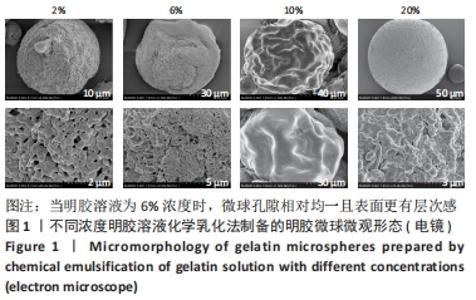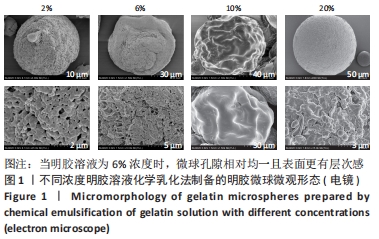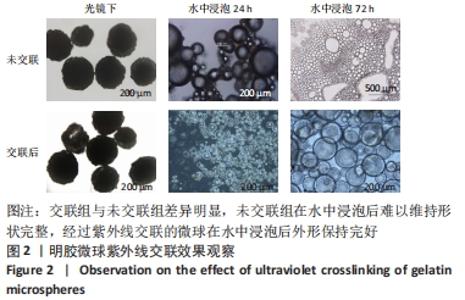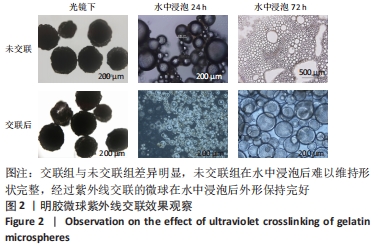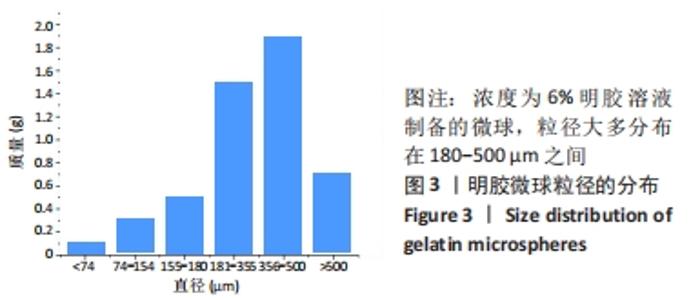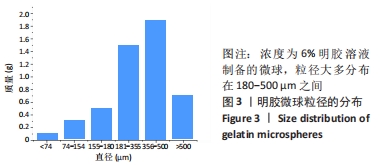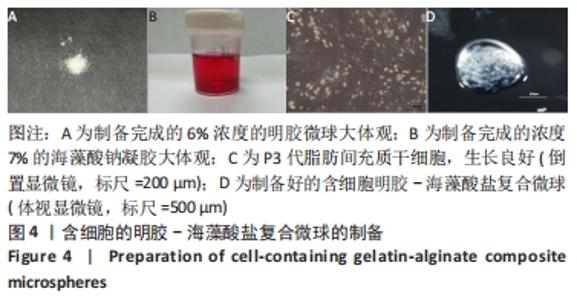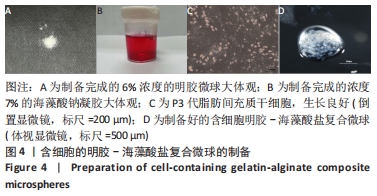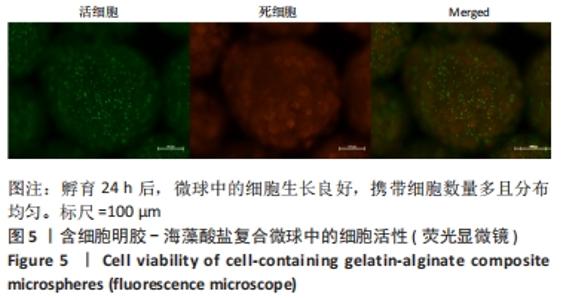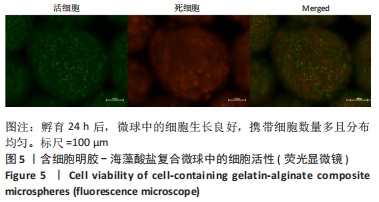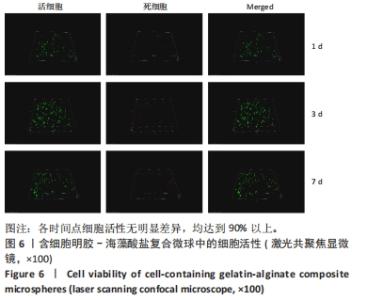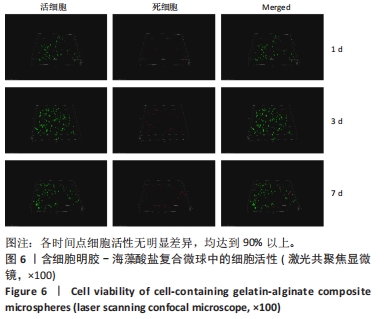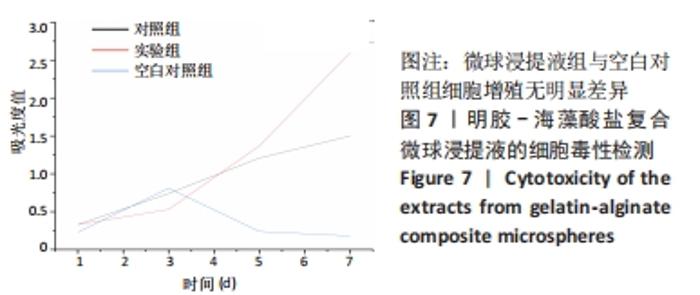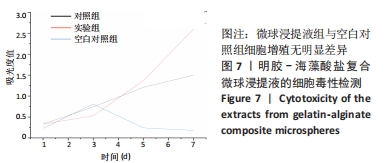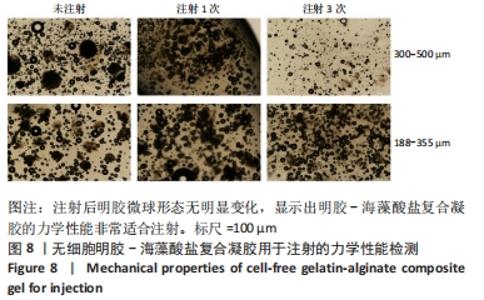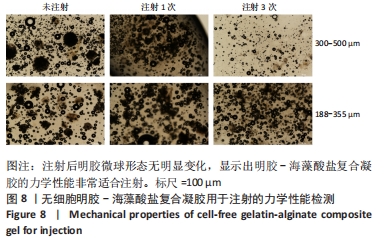Chinese Journal of Tissue Engineering Research ›› 2022, Vol. 26 ›› Issue (28): 4452-4457.doi: 10.12307/2022.297
Previous Articles Next Articles
Gelatin-alginate composite microspheres and gels for cartilage damage repair
Jiang Haoran1, 2, Gao Jianming2, Lin Wancheng1, 2, Li Ting2, Li Huo2, Wang Peng2, Feng Jing2, Meng Haoye2, Peng Jiang2, Ding Lixiang1
- 1Department of Spine Surgery, Beijing Shijitan Hospital Affiliated to Capital Medical University, the Ninth School of Clinical Medicine, Peking University, Beijing 100038, China; 2Institute of Orthopedics, Department of Orthopedics, Army Key Laboratory of Warfare Trauma, Beijing Key Laboratory of Orthopedic Regenerative Medicine PLA, Beijing 100853, China
-
Received:2019-02-19Accepted:2020-03-12Online:2022-10-08Published:2022-03-18 -
Contact:Ding Lixiang, Chief physician, Professor, Department of Spine Surgery, Beijing Shijitan Hospital Affiliated to Capital Medical University, the Ninth School of Clinical Medicine, Peking University, Beijing 100038, China Peng Jiang, Researcher, Institute of Orthopedics, Department of Orthopedics, Army Key Laboratory of Warfare Trauma, Beijing Key Laboratory of Orthopedic Regenerative Medicine PLA, Beijing 100853, China -
About author:Jiang Haoran, Master candidate, Department of Spine Surgery, Beijing Shijitan Hospital Affiliated to Capital Medical University, the Ninth School of Clinical Medicine, Peking University, Beijing 100038, China; Institute of Orthopedics, Department of Orthopedics, Army Key Laboratory of Warfare Trauma, Beijing Key Laboratory of Orthopedic Regenerative Medicine PLA, Beijing 100853, China -
Supported by:the Key medical professional development plan of beijing hospital management center, no. ZYLX202135 (to DLY)
CLC Number:
Cite this article
Jiang Haoran, Gao Jianming, Lin Wancheng, Li Ting, Li Huo, Wang Peng, Feng Jing, Meng Haoye, Peng Jiang, Ding Lixiang. Gelatin-alginate composite microspheres and gels for cartilage damage repair[J]. Chinese Journal of Tissue Engineering Research, 2022, 26(28): 4452-4457.
share this article
Add to citation manager EndNote|Reference Manager|ProCite|BibTeX|RefWorks
| [1] KAISER LR. The future of multihospital systems. Top Health Care Financ. 1992; 18(4):32-45. [2] ZHENG Y, HONG X, WANG J, et al. 2D Nanomaterials for Tissue Engineering and Regenerative Nanomedicines: Recent Advances and Future Challenges. Adv Healthc Mater. 2021;10(7):e2001743. [3] ALDANA AA, ABRAHAM GA. Current advances in electrospun gelatin-based scaffolds for tissue engineering applications. Int J Pharm. 2017;523(2):441-453. [4] FARRUGIA CA, GROVES MJ. Gelatin behaviour in dilute aqueous solution: designing a nanoparticulate formulation. J Pharm Pharmacol. 1999;51(6):643-649. [5] SULAIMAN SB, IDRUS RBH, HWEI NM. Gelatin Microsphere for Cartilage Tissue Engineering: Current and Future Strategies. Polymers(Basel). 2020;12(10):2404. [6] WACHSMUTH L, SÖDER S, FAN Z, et al. Immunolocalization of matrix proteins in different human cartilage subtypes. Histol Histopathol. 2006;21(5):477-485. [7] KRISHNAN Y, GRODZINSKY AJ. Cartilage diseases. Matrix Biol. 2018;71-72:51-69. [8] LE CAIGNEC C, ORY B, LAMOUREUX F, et al. RPL13 Variants Cause Spondyloepimetaphyseal Dysplasia with Severe Short Stature. Am J Hum Genet. 2019;105(5):1040-1047. [9] ZHU HK, YANG L, FANG XF, et al. Effects of intermittent radio frequency drying on structure and gelatinization properties of native potato flour. Food Res Int. 2021; 139:109807. [10] Bittner SM, Pearce HA, Hogan KJ, et al. Swelling behaviors of 3D printed hydrogel and hydrogel-microcarrier composite scaffolds. Tissue Eng Part A. 2021.doi: 10.1089/ten.TEA.2020.0377. [11] ZHANG X, DAI K, LIU C, et al. Berberine-Coated Biomimetic Composite Microspheres for Simultaneously Hemostatic and Antibacterial Performance. Polymers (Basel). 2021;13(3):360. [12] TANAKA N, TAKINO S, UTSUMI I. A new oral gelatinized sustained-release dosage form. J Pharm Sci. 1963;52:664-667. [13] ZHANG S, KANG L, HU S, et al. Carboxymethyl chitosan microspheres loaded hyaluronic acid/gelatin hydrogels for controlled drug delivery and the treatment of inflammatory bowel disease. Int J Biol Macromol. 2021;167:1598-1612. [14] WOLKOW N, JAKOBIEC FA, YOON MK. Gelatin-Based Hemostatic Agents: Histopathologic Differences. Ophthalmic Plast Reconstr Surg. 2018;34(5):452-455. [15] DEWAN I, ISLAM MM, AL-HASAN M, et al. Surface Deposition and Coalescence and Coacervation Phase Separation Methods: In Vitro Study and Compatibility Analysis of Eudragit RS30D, Eudragit RL30D, and Carbopol-PLA Loaded Metronidazole Microspheres. J Pharm (Cairo). 2015; 2015:254930. [16] BASU SK, KAVITHA K, RUPESHKUMAR M. Evaluation of ketorolac tromethamine microspheres by chitosan/gelatin B complex coacervation. Sci Pharm. 2010; 78(1):79-92. [17] HEINEMANN C, HEINEMANN S, KRUPPKE B, et al. Electric field-assisted formation of organically modified hydroxyapatite (ormoHAP) spheres in carboxymethylated gelatin gels. Acta Biomater. 2016;44:135-143. [18] CHOY YB, CHENG F, CHOI H, et al. Monodisperse gelatin microspheres as a drug delivery vehicle: release profile and effect of crosslinking density. Macromol Biosci. 2008;8(8):758-765. [19] CI Y, WANG L, GUO Y, et al. Study on encapsulation of chlorine dioxide in gelatin microsphere for reducing release rate. Int J Clin Exp Med. 2015;8(8):12404-12410. [20] NAKAS A, DALATSI AM, KAPOURANI A, et al. Quality Risk Management and Quality by Design for the Development of Diclofenac Sodium Intra-articular Gelatin Microspheres. AAPS PharmSciTech. 2020;21(4):127. [21] YUAN L, LI X, GE L, et al. Emulsion Template Method for the Fabrication of Gelatin-Based Scaffold with a Controllable Pore Structure. ACS Appl Mater Interfaces. 2019;11(1):269-277. [22] YIN F, CAI J, ZEN W, et al. Cartilage Regeneration of Adipose-Derived Stem Cells in the TGF-β1-Immobilized PLGA-Gelatin Scaffold. Stem Cell Rev Rep. 2015;11(3): 453-459. [23] FREED LE, MARQUIS JC, NOHRIA A, et al. Neocartilage formation in vitro and in vivo using cells cultured on synthetic biodegradable polymers. J Biomed Mater Res. 1993;27(1):11-23. [24] SARIKA PR, JAMES NR. Polyelectrolyte complex nanoparticles from cationised gelatin and sodium alginate for curcumin delivery. Carbohydr Polym. 2016;148: 354-361. [25] SONG W, SU X, GREGORY DA, et al. Magnetic Alginate/Chitosan Nanoparticles for Targeted Delivery of Curcumin into Human Breast Cancer Cells. Nanomaterials (Basel). 2018;8(11):907. [26] DARINI A, ESLAMINEJAD T, NEMATOLLAHI MAHANI SN, et al. Magnetogel Nanospheres Composed of Cisplatin-Loaded Alginate/B-Cyclodextrin as Controlled Release Drug Delivery. Adv Pharm Bull. 2019;9(4):571-577. [27] DOUZANDEH-MOBARREZ B, ANSARI-DOGAHEH M, ESLAMINEJAD T, et al. Preparation and Evaluation of the Antibacterial Effect of Magnetic Nanoparticles Containing Gentamicin: A Preliminary In vitro Study. Iran J Biotechnol. 2018; 16(4):e1559. [28] AFZALI E, ESLAMINEJAD T, YAZDI ROUHOLAMINI SE, et al. Cytotoxicity Effects of Curcumin Loaded on Chitosan Alginate Nanospheres on the KMBC-10 Spheroids Cell Line. Int J Nanomedicine. 2021;16:579-589. [29] YANG IH, CHEN YS, LI JJ, et al. The development of laminin-alginate microspheres encapsulated with Ginsenoside Rg1 and ADSCs for breast reconstruction after lumpectomy. Bioact Mater. 2021;6(6):1699-1710. [30] BROWN KE, LEONG K, HUANG CH, et al. Gelatin/chondroitin 6-sulfate microspheres for the delivery of therapeutic proteins to the joint. Arthritis Rheum. 1998;41(12):2185-2195. [31] TØNNESEN HH, KARLSEN J. Alginate in drug delivery systems. Drug Dev Ind Pharm. 2002; 28(6): 621-630. [32] WHITEMAN KR, SUBR V, ULBRICH K, et al. Poly(Hpma)-coated liposomes demonstrate prolonged circulation in mice. J Liposome Res. 2001;11(2-3):153-164. [33] PICARD F, DEAKIN A, BALASUBRAMANIAN N, et al. Minimally invasive total knee replacement: techniques and results. Eur J Orthop Surg Traumatol. 2018; 28(5):781-791. [34] RUDNIK-JANSEN I, SCHRIJVER K, WOIKE N, et al. Intra-articular injection of triamcinolone acetonide releasing biomaterial microspheres inhibits pain and inflammation in an acute arthritis model. Drug Deliv. 2019;26(1):226-236. [35] KO IK, KEAN TJ, DENNIS JE. Targeting mesenchymal stem cells to activated endothelial cells. Biomaterials. 2009;30(22):3702-3710. [36] YANG J, ZHOU M, LI W, et al. Preparation and Evaluation of Sustained Release Platelet-Rich Plasma-Loaded Gelatin Microspheres Using an Emulsion Method. ACS Omega. 2020;5(42):27113-27118. [37] CHEN X, FAN M, TAN H, et al. Magnetic and self-healing chitosan-alginate hydrogel encapsulated gelatin microspheres via covalent cross-linking for drug delivery. Mater Sci Eng C Mater Biol Appl. 2019;101:619-629. |
| [1] | Tan Xinfang, Guo Yanxing, Qin Xiaofei, Zhang Binqing, Zhao Dongliang, Pan Kunkun, Li Yuzhuo, Chen Haoyu. Effect of uniaxial fatigue exercise on patellofemoral cartilage injury in a rabbit [J]. Chinese Journal of Tissue Engineering Research, 2022, 26(在线): 1-6. |
| [2] | Wu Cong, Jia Quanzhong, Liu Lun. Relationship between transforming growth factor beta1 expression and chondrocyte migration in adult articular cartilage after fragmentation [J]. Chinese Journal of Tissue Engineering Research, 2022, 26(8): 1167-1172. |
| [3] | Xu Lei, Han Xiaoqiang, Zhang Jintao, Sun Haibiao. Hyaluronic acid around articular chondrocytes: production, transformation and function characteristics [J]. Chinese Journal of Tissue Engineering Research, 2022, 26(5): 768-773. |
| [4] | Lin Xuchen, Zhu Hainian, Wang Zengshun, Qi Tengmin, Liu Limin, Suonan Angxiu. Effect of xanthohumol on inflammatory factors and articular cartilage in a mouse mode of osteoarthritis [J]. Chinese Journal of Tissue Engineering Research, 2022, 26(5): 676-681. |
| [5] | Tan Guozhong, Tu Xinran, Guo Liyang, Zhong Jialin, Zhang Yang, Jiang Qianzhou. Biosafety evaluation of three-dimensional printed gelatin/sodium alginate/58S bioactive glass scaffolds for bone defect repair [J]. Chinese Journal of Tissue Engineering Research, 2022, 26(4): 521-527. |
| [6] | Kang Kunlong, Wang Xintao. Research hotspot of biological scaffold materials promoting osteogenic differentiation of bone marrow mesenchymal stem cells [J]. Chinese Journal of Tissue Engineering Research, 2022, 26(4): 597-603. |
| [7] | Zhang Tong, Cai Jinchi, Yuan Zhifa, Zhao Haiyan, Han Xingwen, Wang Wenji. Hyaluronic acid-based composite hydrogel in cartilage injury caused by osteoarthritis: application and mechanism [J]. Chinese Journal of Tissue Engineering Research, 2022, 26(4): 617-625. |
| [8] | Zhang Jian, Lin Jianping, Zhou Gang, Fang Yehan, Wang Benchao, Wu Yongchang. Semi-quantitative MRI evaluation of cartilage degeneration in early knee osteoarthritis [J]. Chinese Journal of Tissue Engineering Research, 2022, 26(3): 425-429. |
| [9] | Liu Ming, Wang Kai. Chitosan/alginate composite scaffold combined with hawthorn leaf flavonoids for spinal cord injury repair [J]. Chinese Journal of Tissue Engineering Research, 2022, 26(28): 4466-4471. |
| [10] | Liu Gang, Gao Lilan, Shi Feifei, Wang Shixin, Luo Lailong, Li Ruixin, Zhang Chunqiu. Preparation and mechanical properties of collagen type II-silk fibroin-hyaluronic acid composite scaffold [J]. Chinese Journal of Tissue Engineering Research, 2022, 26(28): 4519-4524. |
| [11] | Fan Yi, Liu Yadong, Cui Yutao, Liu He, Tian Yuhang, Li Shaorong, Wang Gan, Wu Dankai, Peng Chuangang. Modification of natural and composite alginate hydrogels and repair of bone defect with composite systems [J]. Chinese Journal of Tissue Engineering Research, 2022, 26(28): 4532-4538. |
| [12] | Liu Yin, Liu Qin, Chen Jiao, Gu Xianyang, Chen Jiawen, Ma Minxian. Properties of injectable gluconolactone-sodium alginate/beta-tricalcium phosphate/polyethylene glycol composite hydrogel scaffold [J]. Chinese Journal of Tissue Engineering Research, 2022, 26(27): 4308-4313. |
| [13] | Pan Ziyin , Lu Yi, Jin Liye, Su Dingwen, Shi Hongcan. Latest research progress and application of bio-printing technology in tracheal tissue engineering [J]. Chinese Journal of Tissue Engineering Research, 2022, 26(27): 4393-4400. |
| [14] | Wang Xianfeng, Ou Xin, Deng Biyong. Comparison of effects of exosomes secreted by different mesenchymal stem cells for the treatment of osteoarthritis [J]. Chinese Journal of Tissue Engineering Research, 2022, 26(25): 3980-3985. |
| [15] | Su Jianqing, Sun Bo, Ding Yunrong, Liu Guangming, Ji Wei, Jiang Enyu, Yang Jiayu. Preparing a rabbit model of synovitis in knee osteoarthritis based on the “injury-repair-reinjury” method [J]. Chinese Journal of Tissue Engineering Research, 2022, 26(23): 3738-3743. |
| Viewed | ||||||
|
Full text |
|
|||||
|
Abstract |
|
|||||
